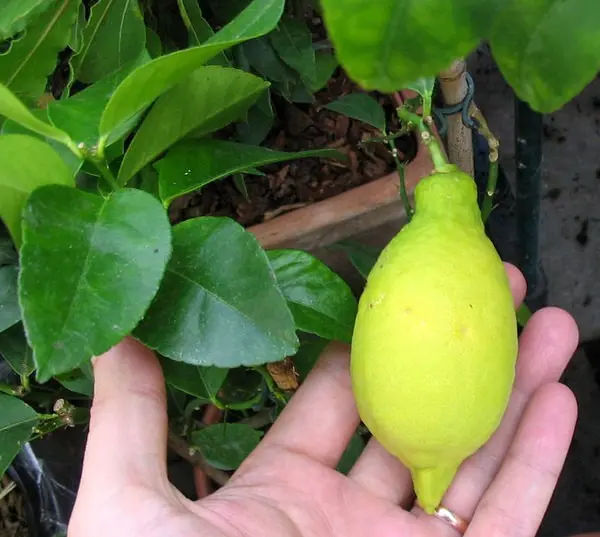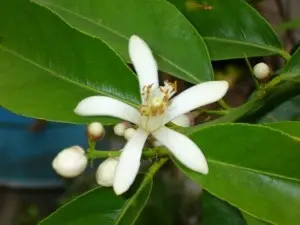

This variety is very common among gardeners. It is notable for the fact that it blooms throughout the season, and not just in spring or autumn.. An interesting fact, the lunario lemon got its name because it begins to bloom on every new moon, thus it depends more not on the season, but on the phase of the moon.
Variety description
More generally, this plant is known as the four-season lunario lemon, since its flowering period lasts all year round, and on an adult tree there are always buds, blossoming flowers, completely green ovaries and ripening fruits at the same time.
Lemon lunario belongs to the tree-like. He is undersized. At home, an adult plant reaches 0,8-1,5 m in height, in rare cases 1,9-2 m. The bark on adult branches is dark gray or brown, young shoots have a dark green tint. The leaves are large, glossy 14-16 cm long, dark green or deep green. They are broad at the base and oval in shape. The petiole is short, up to 1 cm. On the branches there are many sharp spikes 2,5-4 mm tall, brown-violet.
Purple or dark pink buds. The flowers are large, white, bisexual, 4,5-6 cm in diameter. They have a pleasant, fresh, persistent aroma that intensifies when touched. Scattered on the branches singly or collected in a few inflorescences.
The fruits are large or medium in size, oblong elliptical or elongated oval, at the base have a pronounced neck and an elongated, pointed papilla, surrounded by a small groove. As a rule, lemons are close to the branches. Ripe fruits have a pale yellow color, lighter than that of ordinary lemons. The skin is very thin and smooth. The pulp is juicy, not strongly acidic, greenish-yellow in color. In addition, it is very fragrant and easily divided into 9-12 segments. More often, there are no seeds in the fruit or there are 1-2 seeds per large lemon.
The growth rate is active, the annual growth is about 10-15 cm. The crown is prone to thickening and asymmetry, so light pruning is necessary to form a crown of the desired size.

Cultivation
Like all subtropical plants, Lunario lemon requires a lot of light. However, you should not put it on the windowsill in direct sunlight. In winter, when the daylight hours are short, the tree needs additional lighting to ensure the ripening of the fruit and the active development of the plant. All citrus fruits are difficult to tolerate drafts and lowering the temperature in the room.
You should also maintain a relatively high humidity of 65-75%. Water and spray the plant regularly with warm water. To avoid swamping the earthen coma, it is necessary to ensure good drainage in the root part. The substrate must be breathable. It is desirable that its composition contains sand, humus, hardwood and sod land in equal parts. Propagated most often by cuttings.

It is necessary to constantly enrich the soil with minerals and various fertilizers – phosphates, nitrogenous and potassium salts. To accelerate the growth and flowering of a lemon, it is transplanted up to 2-3 times a year or the upper earth layers are renewed if the plant has a widely developed crown. During the period of active flowering, the tree must be provided with complete rest, do not move it or turn it, otherwise the lemon may drop flowers and ovaries.
This lemon gratefully responds to competent care. It is not very whimsical in comparison with other varieties, however, it should be noted that in the summer the fruits of its smaller size, and the winter yield is not so plentiful.
Video “Lemon Lunario – reproduction”
Simple but effective tips for propagating lemon with air layering can be found in the video below.
Author: Svetlana Galitsina
Loading…










